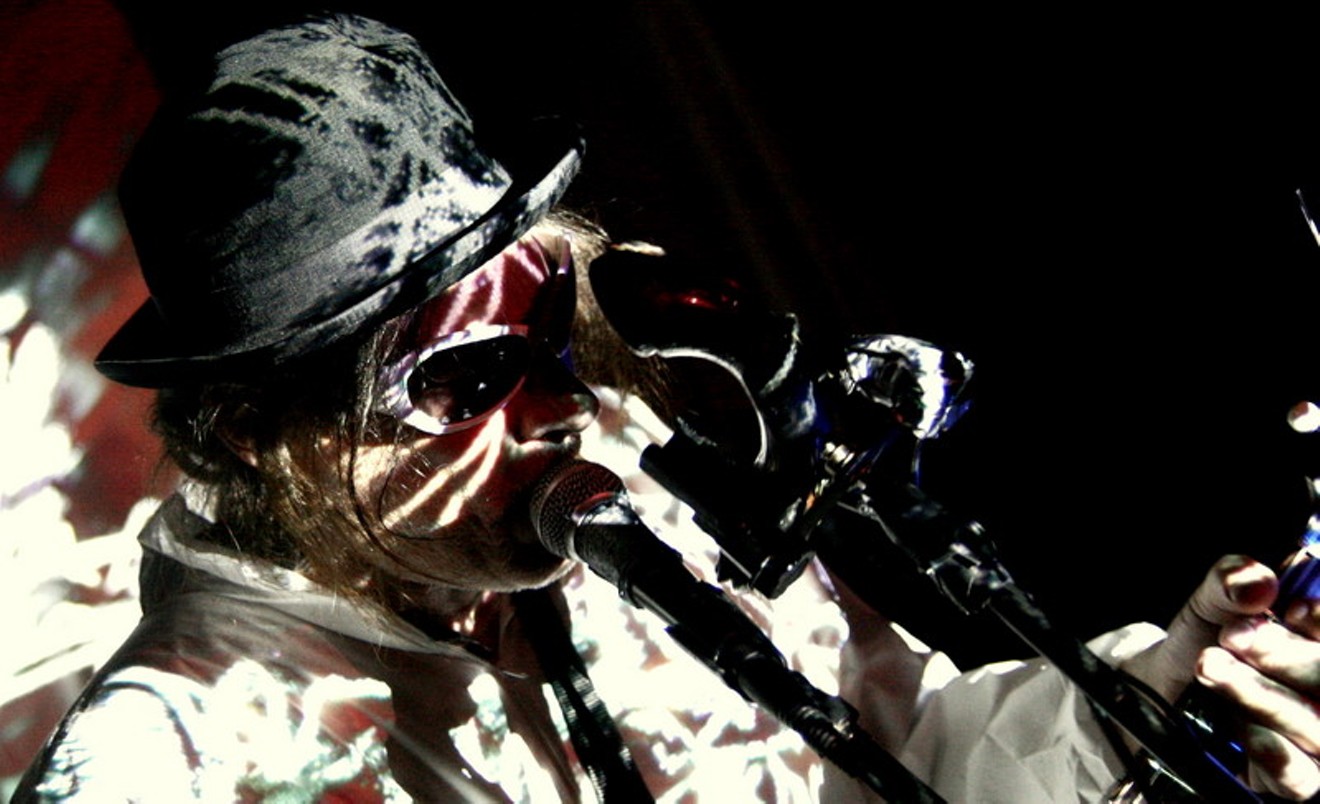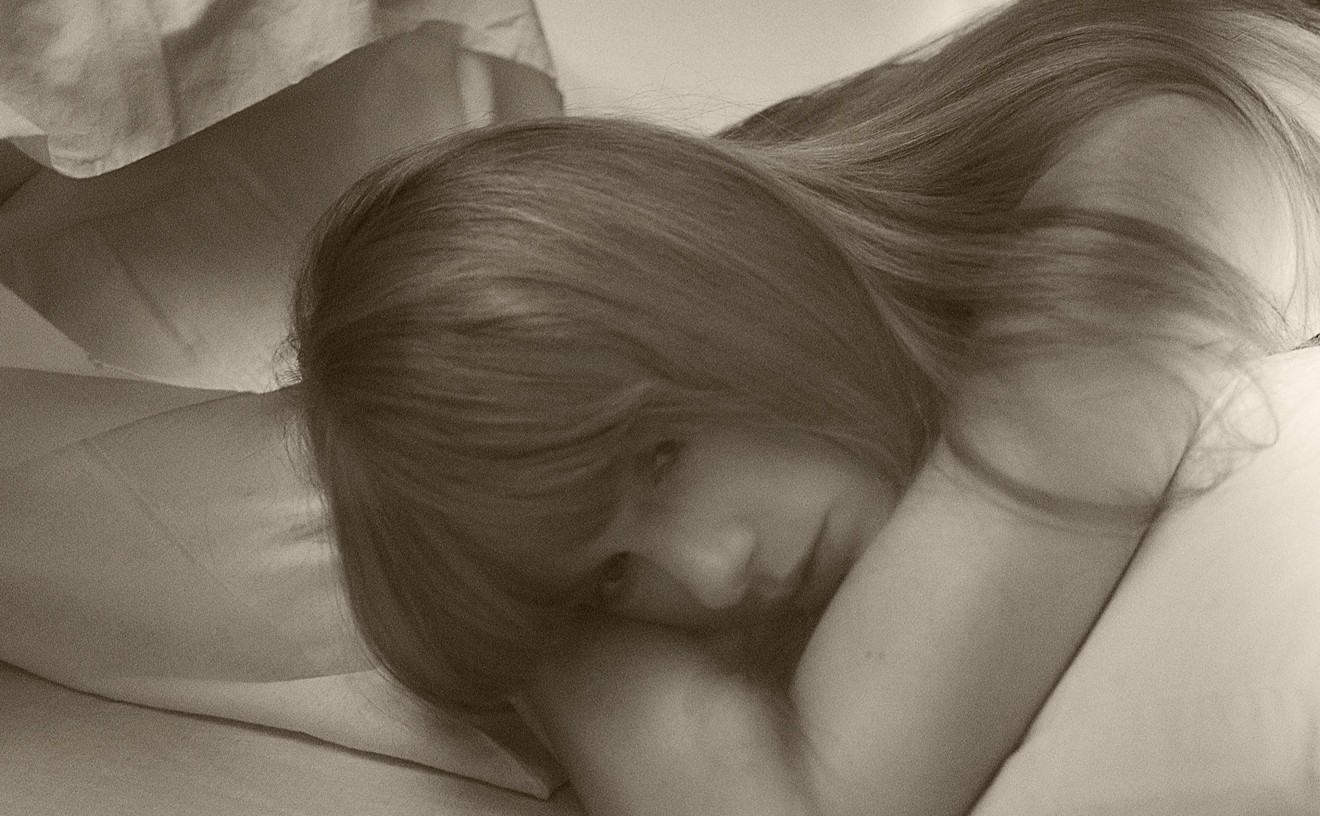When Chrome founder Damon Edge was shopping around the band's debut album, a Warner Brothers A&R rep dismissed it as a "messed-up Doors album." For most musicians, this kind of snide hand-wave would be a crushing blow to the ego. Edge took it as a sign that he was on the right path.
"Messed up" is a great way to describe the body of work Edge and Helios Creed made together as Chrome. The group formed in San Francisco in 1975, and gained notoriety for their chaotic and sprawling sound. They took punk music to the outer fringes, drenching riffs in layers of distortion, TV samples, and weird tape manipulations.
Listening to a Chrome album is an unsettling experience. Songs fade in and out of the mix at random, drums clatter and bang like they're pounded out on trash can lids, and guitar parts sound beamed down from an alien planet that learned to play by listening to Chuck Berry shred on Voyager I.
On album like Alien Soundtracks and Half Machine Lip Moves, the band sound like they're trying to escape the confines of rock music — and Earth.
Edge and Creed drifted apart in the late 1980s. Edge continued touring under the Chrome name until his death in 1995. Creed began working again under the Chrome name in 2014.
The Creed-fronted version of the band is coming to Arizona this month. So we're taking a look back at the forces that helped shape Chrome's music: the bands and artists that inspired them, as well as their San Francisco art-punk contemporaries.
Brion Gysin and William S. Burroughs
The two writers’ experiments with the cut-up technique inspired avant-garde groups to play around with sound and lyrics in the studio. Burroughs and Gysin also helped popularize the music of North Africa with their writings and interest in the Master Musicians of Joujouka. Edge founded Chrome after taking a trip to Morocco in the early '70s that was inspired by the pair's work. Gysin and Burroughs' work became particularly well-known in San Francisco, thanks to industrial musician Monte Cazazza, a pen-pal and occasional collaborator with Burroughs fans/noise pioneers Throbbing Gristle in the U.K.
Where to start: RE/Search #4/5 (1982) goes in depth about their philosophies and working methods. Burroughs' The Job (1969) and his book with Gysin, The Third Mind (1978), delve deep into the cut-up experiments.
The Stooges
More than enough ink has been spilled about The Stooges' impact on punk music. What makes them important in the context of Chrome and other art-punk bands in the late '70s was how many of them took their cues from The Stooges' second LP. Fun House was the record where the band expanded their sound, bringing in saxophonist Steve Mackay to blow some sick and wild licks on the back half of their album. It's no accident that so many art-punks ended up adding some unhinged sax honking to their sound — they learned from the best.
Where to start: Classic-era Stooges only released three albums, and they're all essential. But the most relevant to the art-damaged sound of San Francisco groups like Chrome is Fun House (1970). A gleefully trashy one-night stand between garage rock and free-jazz, it's 36 minutes of perfection.
Hawkwind
This band might seem like the "hippie shit" punks railed against. Hawkwind made long albums about sci-fi stories and outer space. But here's the thing: No matter how much they sound like prog-hippie trash on paper, they rocked. This is the band Lemmy was in before Motorhead. So you know they've got to have some bite to their sound.
The freewheeling, interstellar sound of Hawkwind would prove vastly influential to Chrome's lyrics and songs. Creed was such a huge Hawkwind fan that he ended up touring as part of ex-Hawkwind mastermind Nik Turner's band.
Where to start: In Search Of Space (1971), Space Ritual (1973), and Hall of the Mountain Grill (1974).
The Residents
Still shrouded in mystery, the playful and anonymous members of The Residents were a huge influence on the San Francisco art-punk scene. Originally from Shreveport, Louisiana, the eyeball gang relocated in 1972. Releasing a string of influential records in the '70s, The Residents were known for bizarre concept albums, experiments with sampling and tape edits, and an overall who-gives-a-fuck irreverence that grandfathered them into the punk scene.
The Residents also had a label, Ralph Records, that helped local weirdos get their records out into the world. Although they never released a proper full-length through Ralph Records, Chrome did contribute three tracks to Ralph's 1979 Subterranean Modern compilation (which also included cuts by Tuxedomoon and MX-80 Sound).
Where to start: Meet The Residents (1974), Duck Stab (1978), Eskimo (1979), and The Commercial Album (1980)
Tuxedomoon
One of the most stylistically diverse groups that came up around Chrome's era was Tuxedomoon. Formed in 1977 by multi-instrumentalists Blaine Reininger and Steven Brown, the collective made music focused on electronic sounds. Synthesizers, violin, and saxophone were the cornerstones of the music, which often had a theatrical, otherwordly quality. Opening for Devo and signing with Ralph Records, Tuxedomoon built a big enough following with their avant-garde synth music that it seemed like they were going to cross over and find success as New Wave became ascendant.
Plagued with lineup changes and the feeling that Europe was a better environment and market for their music, Tuxedomoon relocated to Rotterdam in 1981. While their 1985 album Holy Wars achieved some measure of commercial success, they never quite shook their status as a cult band.
Where to start: Half-Mute (1980), Desire (1981), and Holy Wars (1985).
Flipper
The snottiest and sloppiest of the art punks, Flipper galvanized audiences with their antagonistic live shows and slothful sound. While most punk bands were built for speed, Flipper sounded seconds away from nodding off — bass-driven, slow, and distorted, with punch-drunk vocals from Will Shatter and Bruce Loose. A band full of smart and clever musicians, they made gleefully moronic music. The seven-minute "Sex Bomb" is their greatest contribution to Western civilization: a punk "Louie Louie," it bludgeons listeners with music that sounds like it's being recorded by a frat party house band in Hell.
Where to start: Album – Generic Flipper (1982) is a stone-cold masterpiece.
MX-80 Sound
Originally from Bloomington, Indiana, MX-80 Sound occupied a position similar to the one Talking Heads had in the NYC punk scene — as the odd men out. Despite playing many of the same clubs as the rest of the punks in the scene, they were sonic square pegs. In an era where instrumental virtuosity was suspect, MX-80 frontman Bruce Anderson's shit-hot guitar skills raised a few pierced eyebrows.
But MX-80 were still weird enough to get signed by Ralph Records, who put out their killer second album, Out Of The Tunnel, in 1980. The album is full of classic rock riffs and blistering solos, but it also features oodles of distortion, weird spoken passages, and even some sax.
Where to start: Pick up a copy of Out Of The Tunnel (1980) and file it in between your Television and Husker Du records.
Factrix
Joseph T. Jacobs, Carlo McCormick, and Bond Bergland formed Factrix in 1978. While they weren't as prolific as Chrome or The Residents, Factrix crafted a unique and influential sound. Pioneers of industrial music, the trio threw sound-poetry, drones, tape manipulations, and sinister atmospherics into a blender to create a chilling sound that crawls over the listener like a swarm of spiders. In many ways, they sound like Chrome on cough syrup. Factrix took a similar set of influences and studio techniques, but chose to slow them down and let them rot instead of charging out of the garage like Chrome.
Factrix also had connections with the cut-up traditions that inspired Chrome. Their 1982 live LP California Babylon is a collaboration with Monte Cazazza, and it features a musical "cover" of Gysin's cut-up poem "Kick That Habit Man."
Where to start: Scheintot (1981) is some real slick, spooky stuff. A must-have for any lover of post-punk, goth, and creepy psychedelia.
Chrome are playing on Tuesday, March 20, at Club Red in Mesa. Tickets are available via 13th Floor Entertainment.
[
{
"name": "Air - MediumRectangle - Inline Content - Mobile Display Size",
"component": "18478561",
"insertPoint": "2",
"requiredCountToDisplay": "2"
},{
"name": "Editor Picks",
"component": "16759093",
"insertPoint": "4",
"requiredCountToDisplay": "1"
},{
"name": "Inline Links",
"component": "17980324",
"insertPoint": "8th",
"startingPoint": 8,
"requiredCountToDisplay": "7",
"maxInsertions": 25
},{
"name": "Air - MediumRectangle - Combo - Inline Content",
"component": "16759092",
"insertPoint": "8th",
"startingPoint": 8,
"requiredCountToDisplay": "7",
"maxInsertions": 25
},{
"name": "Inline Links",
"component": "17980324",
"insertPoint": "8th",
"startingPoint": 12,
"requiredCountToDisplay": "11",
"maxInsertions": 24
},{
"name": "Air - Leaderboard Tower - Combo - Inline Content",
"component": "16759094",
"insertPoint": "8th",
"startingPoint": 12,
"requiredCountToDisplay": "11",
"maxInsertions": 24
}
]











